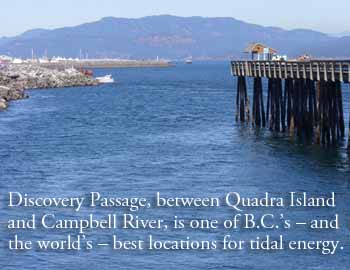
With narrow channels between its islands, and a coast serrated by inlets, B.C. has some of the world’s greatest tidal energy resources. These narrow passageways increase the tidal range and therefore the tide’s kinetic energy. 
Because tides ebb and flow according to regular cycles, they offer clean energy that’s available on a highly predictable basis.
And tidal energy is plentiful — Canada’s total potential from inland rivers and all three coasts has been estimated at two-thirds of the country’s current electricity needs.
The world’s first modern commercial tidal plant was built in 1965 near St. Malo, France. The second followed about 20 years later at Annapolis Royal on Nova Scotia’s Bay of Fundy. But both these projects used barrages, or dams, that block the entrance to a channel or bay.
More recent developments make the barrage unnecessary, allowing marine life and navigation to easily bypass the installation.
That’s the case off the Orkney Islands, where a tidal plant began supplying power to Scotland’s national grid in May 2008.
Three groups of companies plan to test their different turbines side by side at a research station in Nova Scotia. It’s due to open in 2010, although one group hopes to begin testing this year. Situated on Minas Basin, off the Bay of Fundy, this project will take advantage of the world’s largest tidal range. It could eventually generate enough electricity for 10 to 15 per cent of the province’s needs — and some say Fundy’s potential is much greater yet. Nova Scotia now relies heavily on coal-generated electricity, one of the world’s worst sources of greenhouse gases.
On Fundy’s New Brunswick side, the Huntsman Marine Science Centre, an institute renowned for its environmental reputation, has teamed up with industry for an investigation of 11 possible tidal energy sites.
Inland waters also offer tidal possibilities. One company has a proposal for the St. Lawrence that could supply enough electricity for about 11,000 Ontario homes. In Manitoba, studies are underway to determine whether river tides can replace dirty diesel-generated electricity in remote communities. B.C. also has inland potential, but most attention has been focused on the coast.
A Nanaimo company had proposed B.C.’s first commercial tidal plant off the shore of Campbell River. The plan would have created enough energy for 3,000 homes using technology based on an installation in Strangford Lough, Northern Ireland. But after two years of testing and $1 million of investment, the proposal was rejected by BC Hydro. The experience of Scotland, Ulster and Nova Scotia notwithstanding, B.C.’s Crown utility considers tidal technology unproven. The company, meanwhile, is now considering proposals outside the province.
But Discovery Passage, the strait between Campbell River and Quadra Island, hosts some of the world’s best tidal resources. The Haida Gwaii region has also attracted tidal feasibility studies.
At the Race Rocks Provincial Ecological Reserve, 10 nautical miles south of Victoria, a tidal demonstration project has been producing electricity since 2006. Undertaken by a coalition of industry, the federal government and Lester B. Pearson College of the Pacific, this tidal plant replaced a diesel generator that powered the nearby lighthouse. Although small in output, the tidal installation has proved it’s viable in a sensitive ecological sanctuary with the strictest environmental standards.
Also worth checking out...
Green energy resources for B.C.